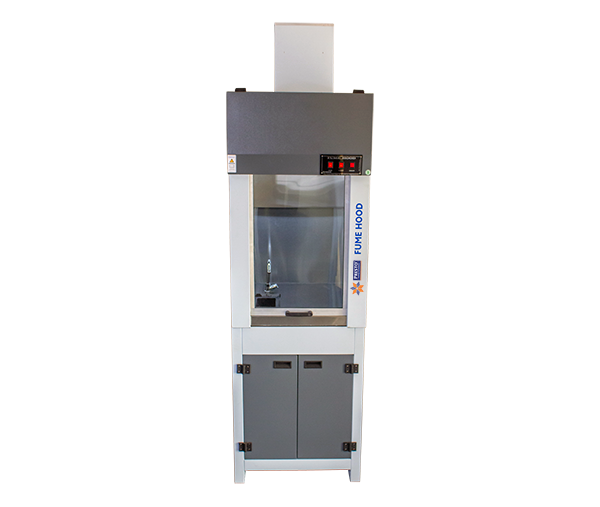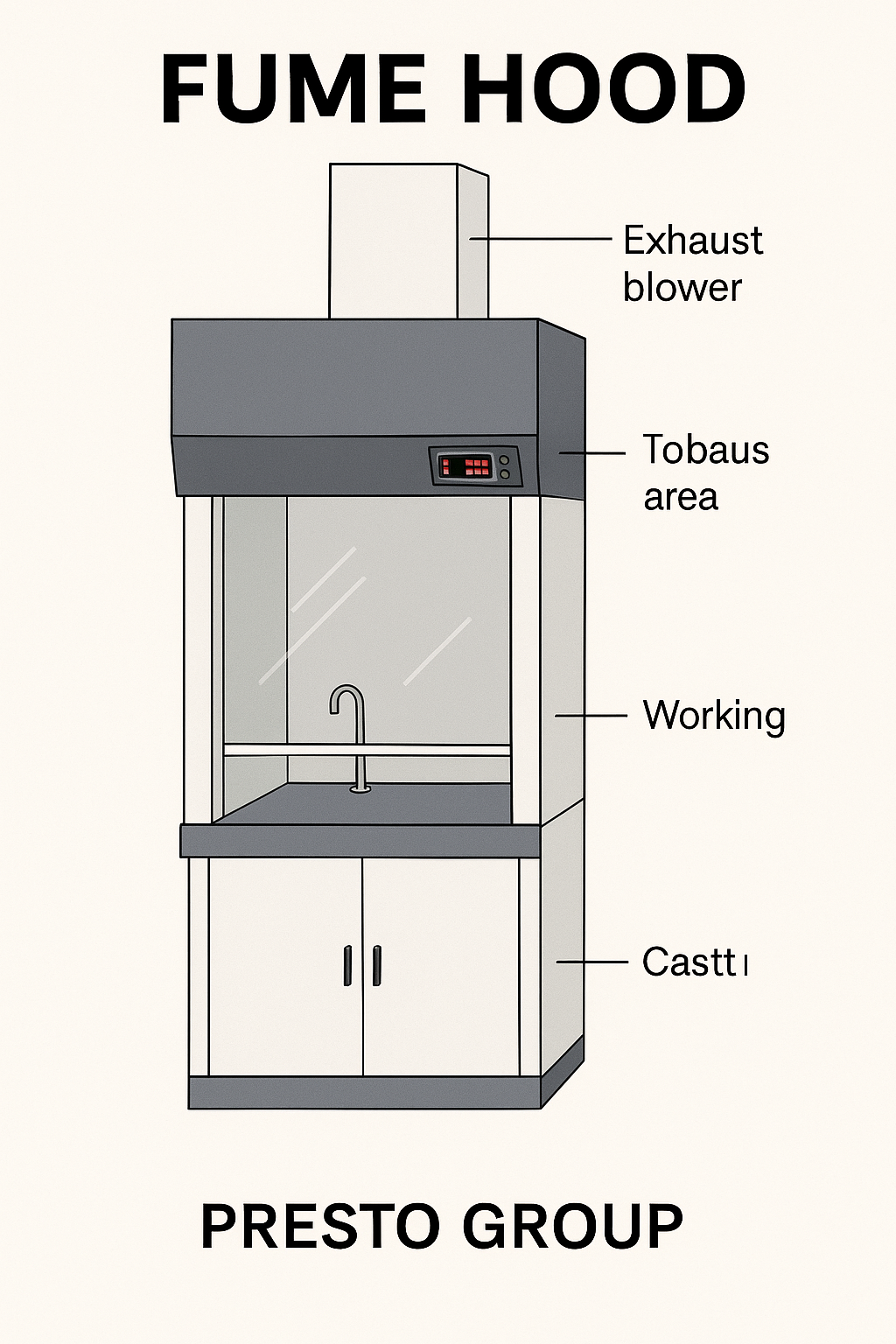
Ever walked into a chemistry lab and seen that big glass fronted box with a humming sound? Kinda looks like something from a science fiction movie, right? That thing is a fume hood your best friend when it comes to staying safe while handling stinky or dangerous chemicals. Whether you're a student messing around with test tubes or a pro researcher mixing hardcore stuff, knowing how a fume hood works is kinda a must.
In this blog, I’ll try to explain everything you should know about a fume hood—how it works, what parts it has, the types out there, and why labs can’t live without one. I'll also add a small table and answer a few FAQs at the end so it's easier to get it all.
Picture this: you’re mixing some chemicals that give off funky, potentially toxic fumes. Without proper protection, you’d be coughing up a storm—or worse. That is where a fume hood comes in. It is basically a ventilated box that sucks up and safely removes harmful fumes, gases, vapors, dust from your workspace. Think of it as a shield between you and the nasty stuff you’re working with. Also called a chemical hood or fume cupboard, it’s a must-have in labs dealing with volatile or toxic substances, like those in chemistry, pharmaceuticals, or even forensics.

A typical fume hood is a large, enclosed workstation with a transparent, movable sash (think of it as a window) that lets you reach in while keeping dangerous stuff contained. It’s usually set at a comfy standing height—about 28 to 34 inches off the floor—and comes in sizes wide enough for one to three people to work at (from 1000 mm to 2000 mm). The whole setup is designed to keep you safe while you tinker with chemicals that could otherwise ruin your day.
A fume hood diagram shows the main parts of a fume hood, like the glass window (sash), fan, vents, and work area. It helps explain how the fume hood pulls out harmful gases and keeps the air clean. This simple diagram helps students and lab workers understand how the fume hood works and how to use it safely.

It’s all about airflow. When the sash is open, the hood pulls in room air—like a mini vacuum cleaner—and creates a low-pressure zone inside. That keeps any dangerous vapors or particles from floating into your face.
Depending on the type:
Most hoods aim for a face velocity (air speed) of 80–120 feet per minute. And yeah, good ones come with alerts if the airflow drops. Safety first!
Each part of a fume hood has a specific job to keep you safe. Here’s a quick rundown in a table for clarity:-
| Part | What It Does |
| Sash | Protects you from fumes and splashes while letting you reach inside. |
| Work Surface | Gives you a sturdy, chemical-proof spot to do your experiments. |
| Baffle System | Guides airflow to evenly pull out fumes and keep things safe. |
| Exhaust Fan | Sucks air through the hood and sends it out or through filters. |
| Airfoil | Smooths out airflow at the entrance to avoid turbulence. |
| Control Panel | Lets you tweak fan speed, lights, and check if everything’s running smoothly. |
| Ducting/Filters | Either vents air outside (ducted) or cleans it for recirculation (ductless). |
These parts team up to make sure your lab stays a safe place to work, no matter how sketchy the chemicals you’re handling.
Not all fume hoods are created equal. There are several types, each built for specific jobs:
Choosing the right one depends on what you’re working with and your lab’s setup.
Fume hoods are like the superheroes of lab safety. Here’s what they’re used for;
If a chemical’s Safety Data Sheet (SDS) says “toxic by inhalation” or “avoid breathing fumes,” you’ll want a fume hood nearby.
Fume hoods get mixed up with other lab gear all the time, so let’s clear the air:-
Fume Hood vs. Biosafety Cabinet:- Fume hoods are all about protecting you from chemical fumes by pulling air in and venting it out. Biosafety cabinets (BSCs) protect you, your samples, and the environment from biological nasties like bacteria or viruses, using HEPA filters. BSCs come in different classes (I, II, III), with some protecting your samples too. Fume hoods? Not sterile, so don’t expect them to keep your samples germ-free.
Fume Hood vs. Laminar Flow Hood:- Laminar flow hoods blow clean, filtered air outward to keep your samples (like cell cultures) free from contamination, but they don’t protect you from hazardous stuff. Fume hoods pull air inward to keep you safe from chemicals but won’t keep your workspace sterile.
Q1: What is the main job of a fume hood?
A: It’s there to keep you safe from harmful fumes, gases, or dust by trapping and removing them. It also acts as a barrier against spills or small explosions.
Q2: How often should you check a fume hood?
A: Get it inspected once a year to make sure the airflow’s on point (80–120 FPM). Most hoods have a sticker showing the last inspection date.
Q3: Can I use a fume hood for biological experiments?
A: Not really. Fume hoods aren’t sterile and don’t protect against pathogens. For bio work, you’re better off with a biosafety cabinet.
Q4: What is the deal with ducted vs. ductless fume hoods?
A: Ducted ones vent fumes outside through pipes, making them versatile for all kinds of chemicals. Ductless ones filter air and release it back into the lab, but they only work for specific chemicals their filters can handle.
A fume hood is a vital lab tool designed to keep harmful fumes away from users by drawing in contaminated air and venting it outside. It has key parts like a sash (glass window), exhaust fan, and airflow system. By using a fume hood, scientists can safely handle chemicals without breathing in toxic vapors—keeping both the lab and its workers safe and healthy.
Fume hood Prices vary depending on type, size, and features. Ductless ones may be cheaper upfront but cost more over time (because of filters). Ducted ones are a bit more complex to install.
If you wanna know the exact cost, just give us a call.
Where to Buy?
You can reach out to Presto Stantest, one of India’s trusted lab equipment suppliers. They’ve got reliable, customizable fume hoods for all kinds of labs.
Email: info@prestogroup.com
Call: +91 9210 903 903
Connect with us for your business enquiries. Generally, we respond within one or two working days.